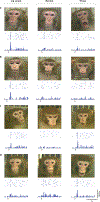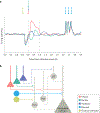Multidimensional processing in the amygdala
- PMID: 32839565
- PMCID: PMC7714370
- DOI: 10.1038/s41583-020-0350-y
Multidimensional processing in the amygdala
Abstract
Brain-wide circuits that coordinate affective and social behaviours intersect in the amygdala. Consequently, amygdala lesions cause a heterogeneous array of social and non-social deficits. Social behaviours are not localized to subdivisions of the amygdala even though the inputs and outputs that carry social signals are anatomically restricted to distinct subnuclear regions. This observation may be explained by the multidimensional response properties of the component neurons. Indeed, the multitudes of circuits that converge in the amygdala enlist the same subset of neurons into different ensembles that combine social and non-social elements into high-dimensional representations. These representations may enable flexible, context-dependent social decisions. As such, multidimensional processing may operate in parallel with subcircuits of genetically identical neurons that serve specialized and functionally dissociable functions. When combined, the activity of specialized circuits may grant specificity to social behaviours, whereas multidimensional processing facilitates the flexibility and nuance needed for complex social behaviour.
Conflict of interest statement
Competing interests
The author declares no competing interests
Figures




References
-
- Laberge F, Mühlenbrock-Lenter S, Grunwald W & Roth G Evolution of the amygdala: new insights from studies in amphibians. Brain Behav. Evol. 67, 177–187 (2006). - PubMed
-
- Brown S & Schafer EA XI. An investigation into the functions of the occipital and temporal lobes of the monkey’s brain. Philos. Trans. R. Soc. London 179, 303–327 (1888).
-
- Meunier M, Bachevalier J, Murray EA, Málková L & Mishkin M Effects of aspiration versus neurotoxic lesions of the amygdala on emotional responses in monkeys: amygdala lesions and emotional responses. Eur. J. Neurosci 11, 4403–4418 (1999). - PubMed
Publication types
MeSH terms
Grants and funding
LinkOut - more resources
Full Text Sources
Research Materials

